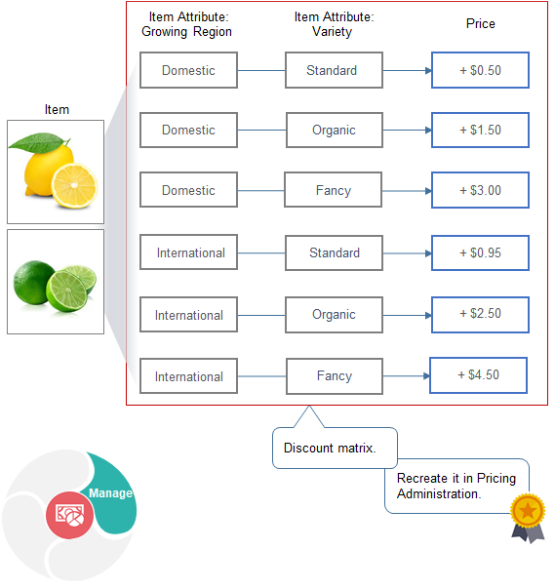Discount Lists
Create a discount list to set up discounts, profit margins, and price overrides for an item.
-
Define a discount for a variety of reasons, such as a seasonal holiday discount, or volume discount according to price or quantity.
-
Apply a flat rate discount or a percent discount.
-
Use a pricing matrix to define a discount according to an item attribute and apply it to the list price at run time. For example, mark up the price of an extra large, red shirt by $10, and apply a 7.5% discount for a blue, large shirt.
Discount Matrix
Use a discount matrix to manage discounts.

Note
-
Use dynamic, declarative rules to define conditions and results that determine price. For example, use the Growing Region attribute and the Variety attribute of the Lemon item as the condition, and the adjustment as the result.
If Growing Region is Domestic, and if Variety is Standard, then adjust price by +$0.50. -
Create a price list matrix or discount matrix that adjusts base price or list price.
-
Create rules according to.
-
Transactional attribute. An attribute that happens on the sales order.
-
Item extensible attribute. An attribute that you define in the Product Information Management work area to meet your specific business requirements. For example, Growing Region could be a transactional attribute and Variety could be an item extensible attribute.
-
Define matrix rules that apply to all items on the order line. Or define matrix rules that apply only to some items on the order line according to the value of an attribute.
-
.For example, if an order line includes 10 domestic standard lemons, and 10 domestic organic lemons, then add $0.50 to the standard lemons, and add $1.50 to the organic lemons.
-
Use a matrix class to create a template that you can reuse with different pricing entities, such as pricing charge, discount, and so on.
-